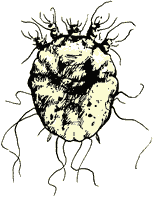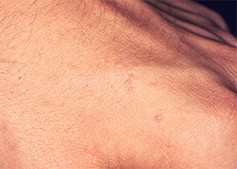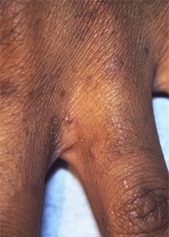PDF 181 KB
Directions you should follow when applying a topical scabicide to treat scabies
 Scabies is an infestation of the skin caused by the scabies mite Sarcoptes scabiei (see image). The mite is very tiny, 0.2 mm to 0.4 mm long, and cannot easily be seen without magnification. It occurs worldwide and in all races and social classes. Scabies is not an indication of poor hygiene.
Scabies is an infestation of the skin caused by the scabies mite Sarcoptes scabiei (see image). The mite is very tiny, 0.2 mm to 0.4 mm long, and cannot easily be seen without magnification. It occurs worldwide and in all races and social classes. Scabies is not an indication of poor hygiene.
Scabies is usually transmitted by direct skin-to-skin contact, or rarely, by underwear or bed clothes that have been freshly contaminated by an infested person. The mites can survive for only a few days off the human or animal body.
 Scabies and other mites usually infest the skin especially where there are creases, such as:
Scabies and other mites usually infest the skin especially where there are creases, such as:
When mites have been transmitted from animals (such as dogs) to people, the mites are commonly found on areas of skin having contact with the animal,  including forearms, chest and neck. However, mites from animals cannot breed on humans, so do not cause ongoing infestation. Scabies mites cause intense itching, especially at night. Thread-like ‘tunnels’, about 10 mm long, may be visible as grey lines in the skin, but they are often difficult to detect. Scabies infection may appear on the genitals as small itchy lumps.
including forearms, chest and neck. However, mites from animals cannot breed on humans, so do not cause ongoing infestation. Scabies mites cause intense itching, especially at night. Thread-like ‘tunnels’, about 10 mm long, may be visible as grey lines in the skin, but they are often difficult to detect. Scabies infection may appear on the genitals as small itchy lumps.
Image courtesy Public Health Image Library (PHIL), Department of Health and Human Services, Centers for Disease Control and Prevention (CDC-USA)
Scabies and other mites that cause skin disease are diagnosed by examining skin scrapings with a microscope.
(time between becoming infected and developing symptoms)
Itching begins 2 to 6 weeks after infestation in individuals not previously exposed to scabies and within 1 to 5 days in individuals previously exposed.
(time during which an infested person can transmit the infestation to others)
Until the mites and eggs are destroyed by treatment. People can be infectious even before the itching begins.
Skin disease caused by mites can easily be confused with other skin diseases. Treatment should not be undertaken until the diagnosis has been confirmed by a doctor, following examination of skin scrapings for mites. This is particularly important for babies, pregnant women or people who already have other forms of skin disease. Babies under 12 months of age need special treatment. Treatment involves application of insecticidal cream, lotion or solution as prescribed by a doctor. For see the Direction for the application of a topical scabicide (PDF 59KB) for detailed information on what you should do and how to apply topical scabicides.
Image 2 and 3 - Scabies (Sarcoptes scabiei var. hominis). Image courtesy of Public Health Image Library (PHIL), Department of Health and Human Services, Centers for Disease Control and Prevention (CDC-USA)